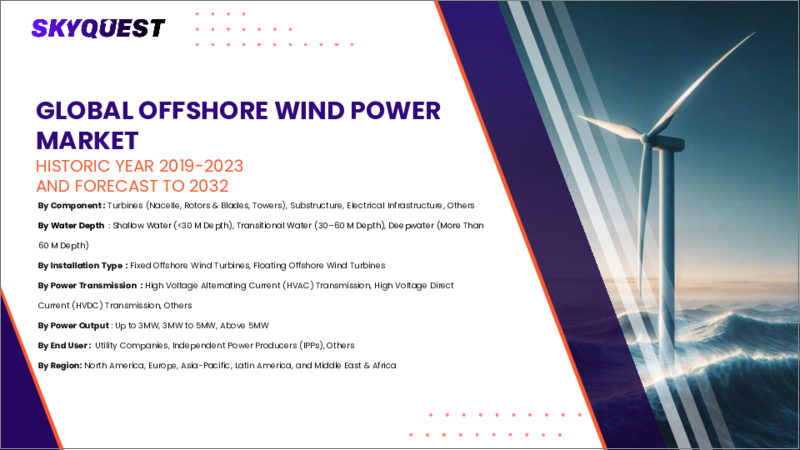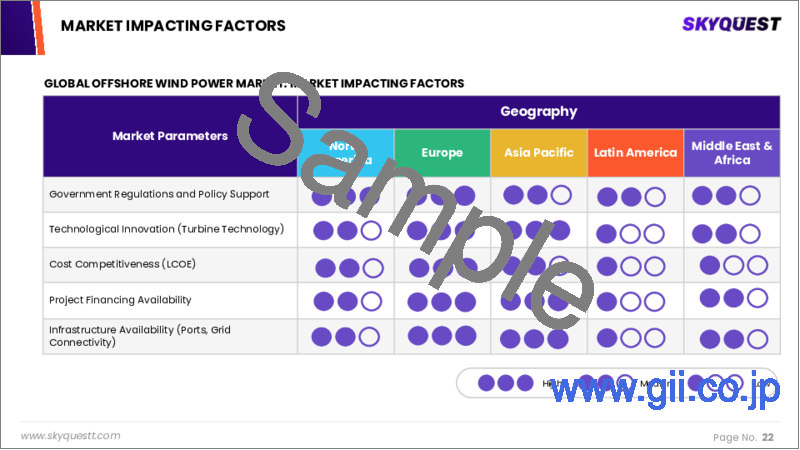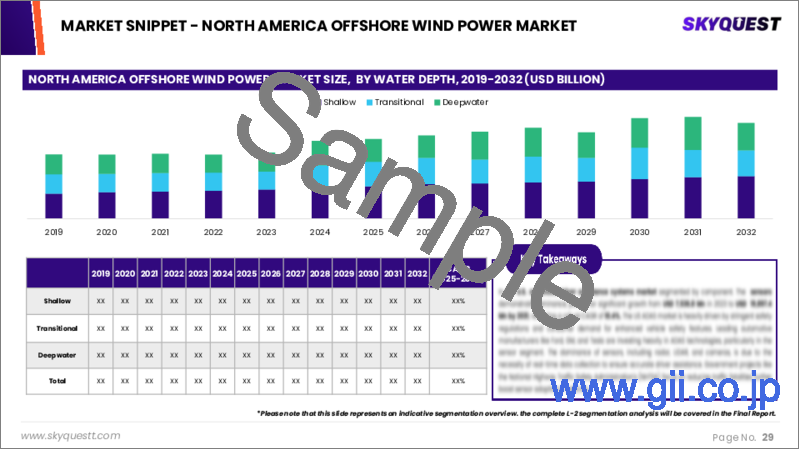|
|
市場調査レポート
商品コード
1603290
オフショア風力の市場規模、シェア、成長分析、コンポーネント別、設置別、深さ別、容量別、地域別 - 産業予測、2024年~2031年Offshore Wind Power Market Size, Share, Growth Analysis, By Component, By Installation, By Depth, By Capacity, By Region - Industry Forecast 2024-2031. |
||||||
|
|||||||
| オフショア風力の市場規模、シェア、成長分析、コンポーネント別、設置別、深さ別、容量別、地域別 - 産業予測、2024年~2031年 |
|
出版日: 2024年11月27日
発行: SkyQuest
ページ情報: 英文 182 Pages
納期: 3~5営業日
|
- 全表示
- 概要
- 目次
オフショア風力の世界市場規模は、2022年に477億米ドルと評価され、2023年の555億米ドルから2031年には1,744億米ドルに成長し、予測期間中(2024-2031年)のCAGRは15.8%で成長する見通しです。
世界のオフショア風力市場は、重要な要因が重なることで力強い成長軌道に乗っています。気候変動に対する意識の高まりと、それに伴う持続可能なエネルギー・ソリューションへの移行の緊急性が、この市場拡大の大きな推進力となっています。再生可能プロジェクト、特にオフショア風力に携わる政府と主要エネルギー企業の双方によって、投資が刺激されています。オフショア風力タービンの設計と建設における技術の進歩は、オフショアエネルギー生産に関連するコストを著しく低下させ、多くの人々にとって実行可能な選択肢となっています。さらに、特に欧州とアジア太平洋地域全体で、支持的な規制の枠組みや有利な政府インセンティブが、市場普及の触媒となっています。オフショアウインドファームから得られる高いエネルギー収量とその大容量は、初期コストの高さやプロジェクト開発の複雑さにもかかわらず、電力会社や独立系発電事業者にとって魅力的な投資先となっています。環境問題への懸念は、市場拡大の大きな課題として残っているが、現在進行中の研究開発努力によってこれらの問題は緩和され、今後数年間は世界のオフショア風力エネルギー分野の持続可能な成長が促進されると期待されています。このように、この市場は、世界の持続可能性の目標と、よりクリーンなエネルギー源に対する需要の高まりに沿った、有望な投資手段となっています。
目次
イントロダクション
- 調査の目的
- 調査範囲
- 定義
調査手法
- 情報調達
- 二次データと一次データの方法
- 市場規模予測
- 市場の前提条件と制限
エグゼクティブサマリー
- 世界市場の見通し
- 供給と需要の動向分析
- セグメント別機会分析
市場力学と見通し
- 市場概要
- 市場規模
- 市場力学
- 促進要因と機会
- 抑制要因と課題
- ポーター分析と影響
- 競争企業間の敵対関係
- 代替品の脅威
- 買い手の交渉力
- 新規参入業者の脅威
- 供給企業の交渉力
主な市場の考察
- 重要成功要因
- 競合の程度
- 主な投資機会
- 市場エコシステム
- 技術の進歩
- 規制情勢
- バリューチェーン分析
- ケーススタディ分析
- PESTEL分析
- マクロ経済指標
- スタートアップ分析
- 市場の魅力指数
- 原材料の分析
- サプライチェーン分析
- 価格分析
オフショア風力の市場規模:コンポーネント別& CAGR(2024-2031)
- 市場概要
- タービン
- ナセル
- ローターとブレード
- タワー
- 下部構造
- 電気インフラ
- その他
オフショア風力の市場規模:設置別& CAGR(2024-2031)
- 市場概要
- 固定構造
- 浮体構造物
オフショア風力の市場規模:深さ別& CAGR(2024-2031)
- 市場概要
- 浅瀬
- 移行期の水
- 深海
オフショア風力の市場規模:容量別& CAGR(2024-2031)
- 市場概要
- 3MW未満
- 3MWから5MW
- 5MW以上
オフショア風力の市場規模:地域別& CAGR(2024-2031)
- 北米
- 米国
- カナダ
- 欧州
- 英国
- ドイツ
- スペイン
- フランス
- イタリア
- その他欧州地域
- アジア太平洋
- 中国
- インド
- 日本
- 韓国
- その他アジア太平洋地域
- ラテンアメリカ
- ブラジル
- その他ラテンアメリカ地域
- 中東およびアフリカ
- GCC諸国
- 南アフリカ
- その他中東・アフリカ
競合情報
- 上位5社の比較
- 主要企業の市場ポジショニング(2023年)
- 主な市場企業が採用した戦略
- 市場の最近の動向
- 企業の市場シェア分析(2023年)
- 主要企業の企業プロファイル
- 会社概要
- 製品ポートフォリオ分析
- セグメント別シェア分析
- 収益の前年比比較(2021-2023)
主要企業プロファイル
- Siemens Gamesa(Spain)
- General Electric(US)
- Vestas(Denmark)
- Goldwind(China)
- Shanghai Electric Wind Power Equipment Co.(China)
- ABB(Switzerland)
- Doosan Heavy Industries and Construction(South Korea)
- Hitachi(Japan)
- Nordex SE(Germany)
- EEW(Germany)
- Nexans(France)
- DEME(Belgium)
- Ming Yang Smart Energy Group Co(China)
- Envision(China)
- Rockwell Automation(US)
- Hyundai Motor Group(South Korea)
- Schneider Electric(France)
- Zhejiang Windey Co.(China)
- Taiyuan Heavy Industry Co.,(China)
- Sinovel(China)
結論と推奨事項
Global Offshore Wind Power Market size was valued at USD 47.7 billion in 2022 and is poised to grow from USD 55.5 billion in 2023 to USD 174.4 billion by 2031, growing at a CAGR of 15.8% during the forecast period (2024-2031).
The global offshore wind power market is on a robust growth trajectory, propelled by a confluence of critical factors. Heightened awareness of climate change and the accompanying urgency to transition to sustainable energy solutions are significant drivers of this expansion. Investments are being stimulated by both governments and key energy companies involved in renewable projects, notably in offshore wind. Technological advancements in offshore wind turbine design and construction have markedly decreased the costs associated with offshore energy production, making it a viable option for many. Furthermore, supportive regulatory frameworks and favorable governmental incentives, especially across Europe and the Asia Pacific regions, catalyze market proliferation. The high energy yield from offshore wind farms and their substantial capacity make them attractive investment prospects for utilities and independent power producers, despite their initial high costs and the complexity of project development. Environmental concerns remain a considerable challenge to market expansion; however, ongoing research and development efforts are expected to alleviate these issues, fostering sustainable growth in the global offshore wind energy sector in the forthcoming years. As such, the market represents a promising avenue for investment, aligned with global sustainability objectives and the increasing demand for cleaner energy sources.
Top-down and bottom-up approaches were used to estimate and validate the size of the Global Offshore Wind Power market and to estimate the size of various other dependent submarkets. The research methodology used to estimate the market size includes the following details: The key players in the market were identified through secondary research, and their market shares in the respective regions were determined through primary and secondary research. This entire procedure includes the study of the annual and financial reports of the top market players and extensive interviews for key insights from industry leaders such as CEOs, VPs, directors, and marketing executives. All percentage shares split, and breakdowns were determined using secondary sources and verified through Primary sources. All possible parameters that affect the markets covered in this research study have been accounted for, viewed in extensive detail, verified through primary research, and analyzed to get the final quantitative and qualitative data.
Global Offshore Wind Power Market Segmental Analysis
Global Offshore Wind Power Market is segmented by Component, Installation, Depth, Capacity and region. Based on component, the market is segmented into Turbines (Nacelle, Rotors & Blades, Tower), Substructure, Electrical Infrastructure, Others. Based on Installation, the market is segmented into Fixed Structure, Floating Structure. Based on Depth, the market is segmented into Shallow Water, Transitional Water, & Deepwater. Based on Capacity, the market is segmented into Up to 3MW, 3MW to 5MW, Above 5MW. Based on region, the market is segmented into North America, Europe, Asia Pacific, Latin America and Middle East & and Africa.
Driver of the Global Offshore Wind Power Market
The Global Offshore Wind Power market is experiencing significant growth driven by a shift towards deeper installations. While the majority of market expansion has historically been in shallow waters, up to 30 meters, there is a noticeable trend towards deeper offshore wind power setups, which extend beyond this depth. This transition is primarily attributed to the increasing viability and efficiency of floating wind turbines, which are designed for deeper water locations. As of 2018, the market share for installations above 30 meters was around 30%, but projections indicate it could reach 50% during the forecast period, spurred by rising investments in deep-water offshore wind projects.
Restraints in the Global Offshore Wind Power Market
The Global Offshore Wind Power market faces significant restraints due to high capital costs and operational complexities. While there is a strong influx of investments, challenges such as the substantial expenses tied to the infrastructure and the intricacies of component installation may hinder the industry's growth prospects. Offshore wind farms, situated in the open seas and oceans where they benefit from consistent high winds, are constantly exposed to harsh environmental conditions. This exposure increases risks like corrosion, cable failures, and physical damage, necessitating ongoing maintenance and repairs, thus making the overall undertaking both complex and costly.
Market Trends of the Global Offshore Wind Power Market
The Global Offshore Wind Power market is witnessing a robust upward trajectory, driven by an increasing commitment to sustainable energy solutions worldwide. As nations prioritize the reduction of carbon emissions, offshore wind energy is rapidly becoming a key component of renewable energy strategies, supported by favorable government policies and incentives. Investments are pouring into technological advancements, making offshore wind a competitive and reliable energy source, which addresses both growing energy demands and climate goals. This trend is complemented by enhanced energy-efficient solutions, positioning offshore wind power as a preferred choice for diversified renewable portfolios, thus expanding market opportunities on a global scale.
Table of Contents
Introduction
- Objectives of the Study
- Scope of the Report
- Definitions
Research Methodology
- Information Procurement
- Secondary & Primary Data Methods
- Market Size Estimation
- Market Assumptions & Limitations
Executive Summary
- Global Market Outlook
- Supply & Demand Trend Analysis
- Segmental Opportunity Analysis
Market Dynamics & Outlook
- Market Overview
- Market Size
- Market Dynamics
- Driver & Opportunities
- Restraints & Challenges
- Porters Analysis & Impact
- Competitive rivalry
- Threat of substitute
- Bargaining power of buyers
- Threat of new entrants
- Bargaining power of suppliers
Key Market Insights
- Key Success Factors
- Degree of Competition
- Top Investment Pockets
- Market Ecosystem
- Technological Advancement
- Regulatory Landscape
- Value Chain Analysis
- Case Study Analysis
- PESTEL Analysis
- Macro-Economic Indicators
- Startup Analysis
- Market Attractiveness Index
- Raw Material Analysis
- Supply Chain Analysis
- Pricing Analysis
Global Offshore Wind Power Market Size by Component & CAGR (2024-2031)
- Market Overview
- Turbines
- Nacelle
- Rotors & Blades
- Tower
- Substructure
- Electrical Infrastructure
- Others
Global Offshore Wind Power Market Size by Installation & CAGR (2024-2031)
- Market Overview
- Fixed Structure
- Floating Structure
Global Offshore Wind Power Market Size by Depth & CAGR (2024-2031)
- Market Overview
- Shallow Water
- Transitional Water
- Deepwater
Global Offshore Wind Power Market Size by Capacity & CAGR (2024-2031)
- Market Overview
- Up to 3MW
- 3MW to 5MW
- Above 5MW
Global Offshore Wind Power Market Size & CAGR (2024-2031)
- North America, (Component, Installation, Depth, Capacity)
- US
- Canada
- Europe, (Component, Installation, Depth, Capacity)
- UK
- Germany
- Spain
- France
- Italy
- Rest of Europe
- Asia-Pacific, (Component, Installation, Depth, Capacity)
- China
- India
- Japan
- South Korea
- Rest of Asia Pacific
- Latin America, (Component, Installation, Depth, Capacity)
- Brazil
- Rest of Latin America
- Middle East & Africa, (Component, Installation, Depth, Capacity)
- GCC Countries
- South Africa
- Rest of Middle East & Africa
Competitive Intelligence
- Top 5 Player Comparison
- Market Positioning of Key Players, 2023
- Strategies Adopted by Key Market Players
- Recent Developments in the Market
- Company Market Share Analysis, 2023
- Company Profiles of All Key Players
- Company Details
- Product Portfolio Analysis
- Company's Segmental Share Analysis
- Revenue Y-O-Y Comparison (2021-2023)
Key Company Profiles
- Siemens Gamesa (Spain)
- Company Overview
- Business Segment Overview
- Financial Updates
- Key Developments
- General Electric (US)
- Company Overview
- Business Segment Overview
- Financial Updates
- Key Developments
- Vestas (Denmark)
- Company Overview
- Business Segment Overview
- Financial Updates
- Key Developments
- Goldwind (China)
- Company Overview
- Business Segment Overview
- Financial Updates
- Key Developments
- Shanghai Electric Wind Power Equipment Co. (China)
- Company Overview
- Business Segment Overview
- Financial Updates
- Key Developments
- ABB (Switzerland)
- Company Overview
- Business Segment Overview
- Financial Updates
- Key Developments
- Doosan Heavy Industries and Construction (South Korea)
- Company Overview
- Business Segment Overview
- Financial Updates
- Key Developments
- Hitachi (Japan)
- Company Overview
- Business Segment Overview
- Financial Updates
- Key Developments
- Nordex SE (Germany)
- Company Overview
- Business Segment Overview
- Financial Updates
- Key Developments
- EEW (Germany)
- Company Overview
- Business Segment Overview
- Financial Updates
- Key Developments
- Nexans (France)
- Company Overview
- Business Segment Overview
- Financial Updates
- Key Developments
- DEME (Belgium)
- Company Overview
- Business Segment Overview
- Financial Updates
- Key Developments
- Ming Yang Smart Energy Group Co (China)
- Company Overview
- Business Segment Overview
- Financial Updates
- Key Developments
- Envision (China)
- Company Overview
- Business Segment Overview
- Financial Updates
- Key Developments
- Rockwell Automation (US)
- Company Overview
- Business Segment Overview
- Financial Updates
- Key Developments
- Hyundai Motor Group (South Korea)
- Company Overview
- Business Segment Overview
- Financial Updates
- Key Developments
- Schneider Electric (France)
- Company Overview
- Business Segment Overview
- Financial Updates
- Key Developments
- Zhejiang Windey Co.(China)
- Company Overview
- Business Segment Overview
- Financial Updates
- Key Developments
- Taiyuan Heavy Industry Co., (China)
- Company Overview
- Business Segment Overview
- Financial Updates
- Key Developments
- Sinovel(China)
- Conclusio Company Overview
- Business Segment Overview
- Financial Updates
- Key Developments





